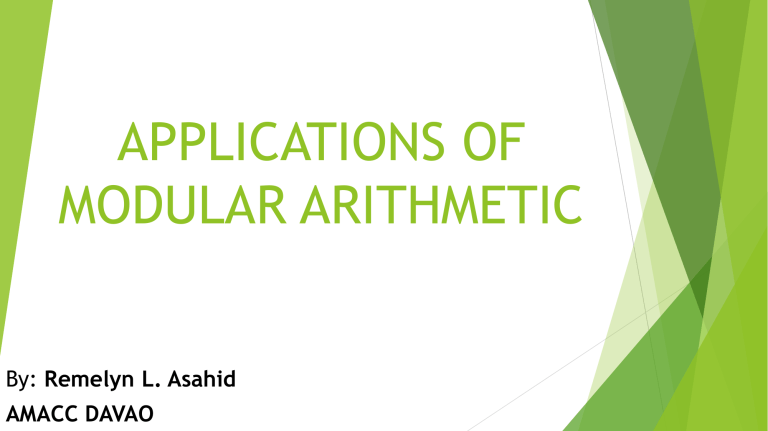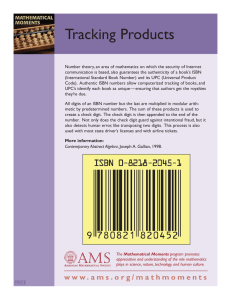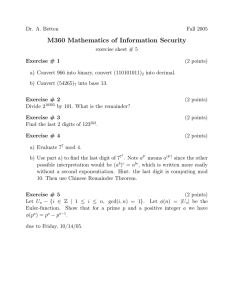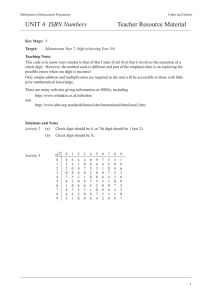
APPLICATIONS OF MODULAR ARITHMETIC By: Remelyn L. Asahid AMACC DAVAO OBJECTIVES 1.Apply modular arithmetic in determining ISBN check digit and UPC. 2.Determine a valid card number using modular arithmetic. 3.Encode messages using modular arithmetic. By: Remelyn L. Asahid AMACC DAVAO What The ISBN Check Digit Is For The check digit in an ISBN number is there to help prevent errors in transmission. When an ISBN number is read and entered into any system that is used to deal with ISBNs, such as a book cataloguing system, whether the ISBN is entered by hand or by means of a bar code scanner, the check digit as read from the entered number is compared to a check digit calculated from the remainder of the ISBN that has been entered. If the two check digits are the same, then there is a good chance that the complete ISBN, all of its digits, has been read correctly. As an example, if I enter the ISBN 9781861972712 into a system that uses ISBNs, it will take the first twelve digits (978186197271) of the ISBN and calculate the check digit for that series of twelve digits. It will come up with the number 2 as the correct digit and compare it to the number that I entered earlier, and find that I entered the number 2 as well. In that case, the chances are I entered the digits correctly. However, supposing I entered the ISBN incorrectly and made a mistake by transposing the fifth and sixth digits, entering the ISBN as 9781681972712. When the system calculate the check digit for 978168197271 it will come up with 8 as the check digit for that number. It will compare 8 with 2 and know that a mistake of some sort has been made. It won't know where the error is, only that something is wrong. By: Remelyn L. Asahid AMACC DAVAO By: Remelyn L. Asahid How The ISBN Check Digit Is Calculated This is the process: 1. Take the first 12 digits of the 13-digit ISBN 2. Multiply each number in turn, from left to right by a number. The first digit is multiplied by 1, the second by 3, the third by 1 again, the fourth by 3 again, and so on to the eleventh which is multiplied by 1 and the twelfth by 3. 3. Add all of the 12 answers. 4. Do a modulo 10 division on the result from step 2. 5. Take that remainder result from step 4.If it's a zero, then the check digit is zero. If the remainders isn't zero then subtract the remainder from 10. The answer to that is your check digit. By: Remelyn L. Asahid AMACC DAVAO By: Remelyn L. Asahid AMACC DAVAO By: Remelyn L. Asahid AMACC DAVAO By: Remelyn L. Asahid AMACC DAVAO By: Remelyn L. Asahid AMACC DAVAO D12 = 10 – [(3*7) + 6 + (3*7) + 6 + (3*8) + 5 + (3*1) + 0 + (3*5) + 4 + (3*6) mod 10 = 10 – (21 + 6 + 21 + 6 + 24 + 5 + 3 + 0 + 15 + 4 + 18) mod 10 = 10 - 123 mod 10 = 10 – 3 =7 By: Remelyn L. Asahid AMACC DAVAO D12 = 10 – [(3*0) + 4 + (3*0) + 0 + (3*0) + 0 + (3*1) + 5 + (3*1) + 6 + (3*6) mod 10 = 10 – (0 + 4 + 0 + 0 + 0 + 0 + 3 + 5 + 3 + 6 + 18) mod 10 = 10 - 39 mod 10 = 10 – 9 =1 By: Remelyn L. Asahid AMACC DAVAO By: Remelyn L. Asahid AMACC DAVAO By: Remelyn L. Asahid AMACC DAVAO The Luhn algorithm or Luhn formula, also known as the "modulus 10" or "mod 10" algorithm, named after its creator, IBM scientist Hans Peter Luhn, is a simple checksum formula used to validate a variety of identification numbers, such as credit card numbers, IMEI numbers, National Provider Identifier numbers in the United States, Canadian Social Insurance Numbers, Israeli ID Numbers, South African ID Numbers, Greek Social Security Numbers (ΑΜΚΑ), and survey codes appearing on McDonald's, Taco Bell, and Tractor Supply Co. receipts. It is described in U.S. Patent No. 2,950,048, filed on January 6, 1954, and granted on August 23, 1960. By: Remelyn L. Asahid AMACC DAVAO The formula verifies a number against its included check digit, which is usually appended to a partial account number to generate the full account number. This number must pass the following test: From the rightmost digit (excluding the check digit) and moving left, double the value of every second digit. The check digit is neither doubled nor included in this calculation; the first digit doubled is the digit located immediately left of the check digit. If the result of this doubling operation is greater than 9 (e.g., 8 × 2 = 16), then add the digits of the result (e.g., 16: 1 + 6 = 7, 18: 1 + 8 = 9) or, alternatively, the same final result can be found by subtracting 9 from that result (e.g., 16: 16 − 9 = 7, 18: 18 − 9 = 9). Take the sum of all the digits (including the check digit). If the total modulo 10 is equal to 0 (if the total ends in zero) then the number is valid according to the Luhn formula; otherwise it is not valid. By: Remelyn L. Asahid AMACC DAVAO Example for computing check digit By: Remelyn L. Asahid AMACC DAVAO By: Remelyn L. Asahid AMACC DAVAO By: Remelyn L. Asahid AMACC DAVAO By: Remelyn L. Asahid AMACC DAVAO By: Remelyn L. Asahid AMACC DAVAO Cryptography and Modular Arithmetic https://www.math.ust.hk/~yangwang/Co urse/2016FSMath4999/Week%201/cryptoneu%20notes.pdf That’s the end of WEEK 13! By: Remelyn L. Asahid AMACC DAVAO




